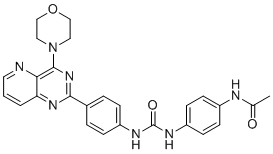
PI3Kα-IN-4h
CAS No. 2100855-80-7
PI3Kα-IN-4h ( —— )
Catalog No. M13328 CAS No. 2100855-80-7
PI3Kα-IN-1 is a potent, selective, ATP-competitive dual PI3Kα/mTOR inhibitor with IC50 of 0.5/104 nM respectively.
Purity : >98% (HPLC)
 COA
COA
 Datasheet
Datasheet
 HNMR
HNMR
 HPLC
HPLC
 MSDS
MSDS
 Handing Instructions
Handing Instructions
| Size | Price / USD | Stock | Quantity |
| 100MG | Get Quote | Get Quote |


|
| 200MG | Get Quote | Get Quote |


|
| 500MG | Get Quote | Get Quote |


|
| 1G | Get Quote | Get Quote |


|
Biological Information
-
Product NamePI3Kα-IN-4h
-
NoteResearch use only, not for human use.
-
Brief DescriptionPI3Kα-IN-1 is a potent, selective, ATP-competitive dual PI3Kα/mTOR inhibitor with IC50 of 0.5/104 nM respectively.
-
DescriptionPI3Kα-IN-1 is a potent, selective, ATP-competitive dual PI3Kα/mTOR inhibitor with IC50 of 0.5/104 nM respectively; displays good selectivity for PI3Kα; demonstrates cytotoxicity in MCF7 cells, reasonable toxicity in MDA-MB-468 cells, good therapeutic index compared to normal skin fibroblasts, and acceptable in vitro ADME properties.
-
Synonyms——
-
PathwayPI3K/Akt/mTOR signaling
-
TargetPI3K
-
RecptorPI3K
-
Research Area——
-
Indication——
Chemical Information
-
CAS Number2100855-80-7
-
Formula Weight483.53
-
Molecular FormulaC26H25N7O3
-
Purity>98% (HPLC)
-
Solubility——
-
SMILES——
-
Chemical NameN-(4-(3-(4-(4-morpholinopyrido[3,2-d]pyrimidin-2-yl)phenyl)ureido)phenyl)acetamide
Shipping & Storage Information
-
Storage(-20℃)
-
ShippingWith Ice Pack
-
Stability≥ 2 years
Reference
1. Al-Ashmawy AAK, et al. Bioorg Med Chem Lett. 2017 Jul 15;27(14):3117-3122.
molnova catalog


related products
-
GNE-317
GNE-317 (GNE317) is a potent, brain penepenetrant, dual PI3K/mTOR inhibitor having physicochemical properties predictive of low efflux by P-gp and BCRP.
-
LY3023414
LY3023414 is a potent, dual PI3K/mTOR inhibitor.
-
GSK251
GSK251 is a highly potent, highly selective, orally bioavailable inhibitor of PI3Kδ with a novel binding mode.



 Cart
Cart
 sales@molnova.com
sales@molnova.com


